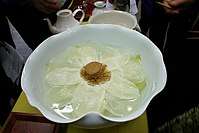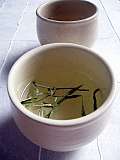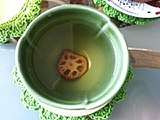Lotus tea
Lotus tea is an infusion made from lotus leaves, flowers, roots, fruit, seeds, or embryos. It is known as liánchá (莲茶, 蓮茶, [ljɛ̌n.ʈʂʰǎ]) in Chinese and yeoncha (연차, 蓮茶, [jʌn.tɕʰa]) in Korean.
| Lotus tea | |
|---|---|
 | |
| Type | Herbal tea |
| Other names |
|
| Origin | Asia |
| Quick description | Tea made from lotus leaves, flowers, roots, seeds, or fruit |
| Temperature | Varies |
| Time | Varies |
Lotus leaf tea
Lotus leaf tea, called yeonnip-cha (연잎차 [jʌn.nip̚.tɕʰa]) in Korean, is a tea made from young leaves of lotus.[1] Leaves for lotus tea are often heat-treated (either by steaming or roasting) before being dried.[1] Sometimes, fresh leaves are also infused as tea. 6–12 g (0.21–0.42 oz) of dried leaves or 15–20 g (0.53–0.71 oz) or fresh leaves are simmered in 600 ml (21 imp fl oz; 20 US fl oz) of water over low heat to produce two to three cups tea.[2]
 Slicing lotus leaves
Slicing lotus leaves Roasting lotus leaves
Roasting lotus leaves Steamed lotus leaves
Steamed lotus leaves Drying steamed lotus leaves
Drying steamed lotus leaves Dried steamed lotus leaves
Dried steamed lotus leaves A tea bag of lotus leaf tea
A tea bag of lotus leaf tea Lotus leaf tea
Lotus leaf tea
Lotus flower tea
Lotus flower tea, called yeonkkot-cha (연꽃차, [jʌn.k͈ot̚.tɕʰa]) or yeonhwa-cha (연화차, 蓮花茶, [jʌn.ɦwa.tɕʰa]) in Korean, is a tea made from lotus flower.[3] Often, a fresh whole flower is used to make tea. In Korean temple cuisine, this type of lotus flower tea symbolizes the blossoming of Buddhist enlightenment.[4] Otherwise, 4–8 g (0.14–0.28 oz) of dried petals can be simmered in 600 ml (21 imp fl oz; 20 US fl oz) of water over low heat to make two to three cups or of tea.[2]
 Making lotus flower tea
Making lotus flower tea Lotus flower opening
Lotus flower opening Lotus flower tea (fully opened)
Lotus flower tea (fully opened)
Lotus fruit tea
Lotus fruit tea, called yeonbang-cha (연방차, 蓮房茶, [jʌn.baŋ.tɕʰa]) in Korean, is a tea made by infusing dried lotus fruits.[3]
Lotus seed tea
Lotus seed tea, called yeonbap-cha (연밥차, [jʌn.bap̚.tɕʰa]), yeonssi-cha (연씨차, [jʌn.s͈i.tɕʰa]), or yeonja-cha (연자차, 蓮子茶, [jʌn.dʑa.tɕʰa]) in Korean, is a tea made by infusing lotus seeds, which are steamed and dried.[2] For two to three cups of tea, 5–10 g (0.18–0.35 oz) of lotus seeds are simmered in 600 ml (21 imp fl oz; 20 US fl oz) water over low heat.[2]
Lotus embryo tea
Lotus embryo tea, called liánxīn-chá (莲芯茶, 蓮芯茶, [ljɛ̌n.ɕín.ʈʂʰǎ]) or liánzixīn-chá (莲子芯茶, 蓮子芯茶, [ljɛ̌n.tsi.ɕín.ʈʂʰǎ]) in Chinese and trà tim sen (Northern: [tɕâː.tīm.sɛ̄n], Southern: [ʈâː.tīm.ʂɛ̄ŋ]) in Vietnamese, is an infusion made from lotus embryos.[5]
Lotus root tea
Lotus root tea, called yeongeun-cha (연근차, 蓮根茶, [jʌn.ɡɯn.tɕʰa]) in Korean, is a tea made by infusing dried lotus root (rhizome) slices or mixing lotus root powder in hot water. Lotus root powder for tea can be made by either by drying lotus root juice, or grinding dried lotus root slices into powder.[2]
 Dried lotus root slices
Dried lotus root slices Infusing dried lotus root slices
Infusing dried lotus root slices Lotus root tea
Lotus root tea
References
- Jeong, Dong-hyo; Yun, Baek-hyeon; Yi, Yeong-hui, eds. (2012). "Yeonnip-cha". Cha saenghwal munhwa daejeon (in Korean). Seoul, Korea: Hongikjae. ISBN 978-89-714-3351-5. Retrieved 28 February 2018 – via Naver.
- Jeong, Dong-hyo; Yun, Baek-hyeon; Yi, Yeong-hui, eds. (2012). "Yeoncha". Cha saenghwal munhwa daejeon (in Korean). Seoul, Korea: Hongikjae. ISBN 978-89-714-3351-5. Retrieved 28 February 2018 – via Naver.
- Park, Jin-hai (29 October 2013). "Serving lotus, from flower to seed". The Korea Times. Retrieved 28 February 2018.
- Gordinier, Jeff (16 October 2015). "Jeong Kwan, the Philosopher Chef". The New York Times. Retrieved 28 February 2018.
- Song, Lê (5 January 2014). "Những loại trà có ích cho bệnh nhân tiểu đường". VnExpress (in Vietnamese). Retrieved 28 February 2018.